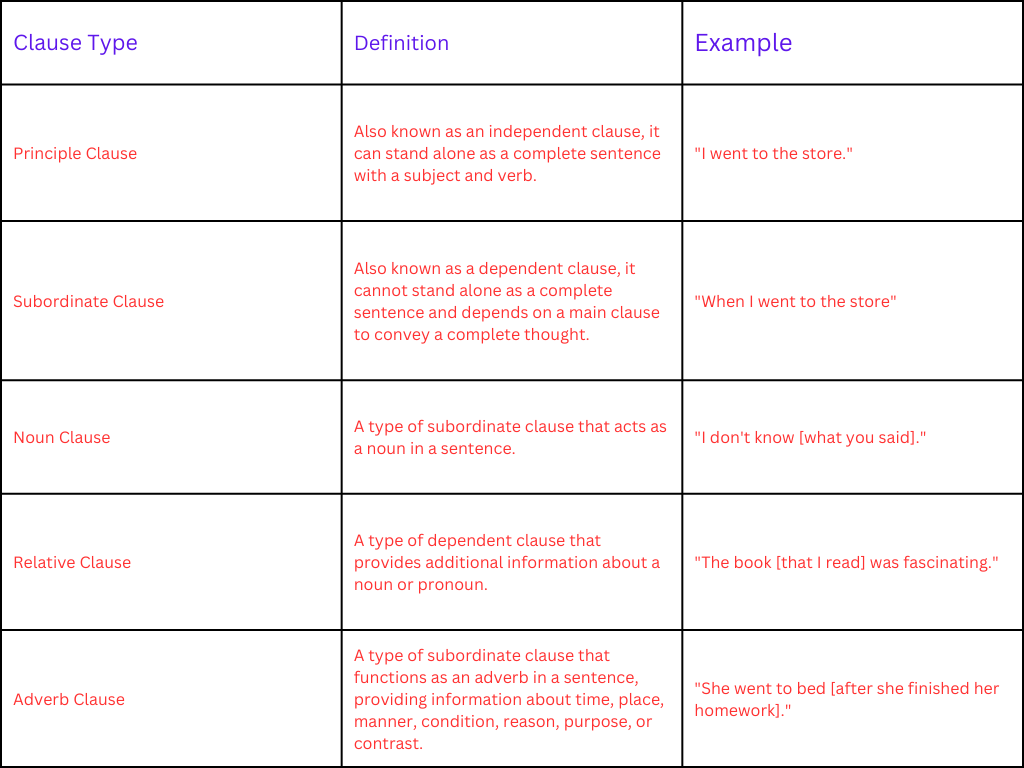Introduction:
I am sure you want to focus on understanding sentence structure . Right ? When it comes to constructing sentences, understanding the various components and their roles is essential. One crucial aspect of sentence structure is clauses. Clauses play a vital role in conveying meaning and organizing thoughts within a sentence. In this article, we will explore different types of clauses, including the principle clause, subordinate clause, noun clause, relative clause, and adverb clause, and delve into their characteristics and functions.
| Clause Type | Definition | Examples |
|---|---|---|
| Principal Clause | A clause that can stand alone as a complete sentence and expresses a complete thought. | “I saw a man crying.” |
| Subordinate Clause | A clause that cannot stand alone as a complete sentence and depends on the main clause for meaning. | “When Jack blew the whistle, the dog stopped running.” |
| Noun Clause | A type of subordinate clause that functions as a noun in a sentence. | “I like what I see. “I know that patience has its limits.” |
| Relative Clause | A dependent clause that provides additional information about a noun in the main clause. | “Jack, who’s retired now, spends a lot of time with his grandchildren.”We want to see the new Tom Carter film, which was released on Friday.” |
| Adverb Clause | A subordinate clause that functions as an adverb, providing information about the main clause. | “I had something to eat before leaving. “I like innovation.” |
1. Principle Clause | Understanding Sentence Structure
The principle clause, also known as an independent clause, is a fundamental building block of a sentence. It can stand alone as a complete sentence because it expresses a complete thought. Let’s consider an example:
- “She went to the store.”
2. Subordinate Clause:
Unlike the principle clause, a subordinate clause, also called a dependent clause, cannot stand alone as a complete sentence. It relies on the principle clause to convey its full meaning. Here’s an example:
- “Although she was tired, she continued working.”
3. Noun Clause:
When talking about noun clause, it works as a noun within a particular sentence. It can act as the subject, object, or complement. Here’s an example:
- “What he said is quite intriguing.”

4. Relative Clause | Understanding Sentence Structure
A relative clause provides additional information about a noun or pronoun in a sentence. It begins with a relative pronoun or adverb such as “who,” “which,” “that,” or “where.” Consider the following example:
- “The book that I borrowed from the library was fascinating.”
5. Adverb Clause:
An adverb clause functions as an adverb within a sentence, modifying a verb, adjective, or another adverb. It typically begins with subordinating conjunctions like “although,” “because,” “if,” or “when.” Here’s an example:
- “She will join the party if she finishes her work on time.”
Understanding the Difference:
The main distinction between a principle clause and a subordinate clause lies in their ability to stand alone. While the principle clause can function independently, a subordinate clause depends on the principle clause for its meaning and cannot exist independently.
Principle of Subordinate Clauses | Understanding Sentence Structure
Subordinate clauses provide additional information, add complexity to sentences, and establish relationships between ideas. They help to create more nuanced and varied sentence structures, enhancing the overall flow and richness of our language.
Examples of Subordinate Clauses:
- “Although she studied hard, she didn’t pass the exam.”
- “After the show ended, everyone applauded.”
Principal Clause:
The principal clause, also referred to as an independent clause, expresses a complete thought and can function as a standalone sentence.
Three Subordinate Clauses | Understanding Sentence Structure
- Adjective Clauses: These modify nouns or pronouns and provide additional descriptive information.
- Adverbial Clauses: These modify verbs, adjectives, or adverbs and provide information about time, place, reason, condition, or manner.
- Noun Clauses: These function as nouns within a sentence, acting as subjects, objects, or complements.
Four Subordinate Clauses:
- Adjective Clauses: These modify or describe nouns or pronouns.
- Adverb Clauses: These can change either verbs, adjectives, or adverbs.
- Noun Clauses: These function as nouns within sentences.
- Relative Clauses: These provide additional information about a noun or pronoun.
Why is it called a Subordinate Clause? A subordinate clause is called so because it cannot function independently but relies on the principle clause to complete its meaning. It is subordinate to the main clause within a sentence.
Subordinate Clause Examples | Understanding Sentence Structure
- “Although he was tired, he could easily hand over the project.”
- “When he came to school , he ran towards the classroom.”
- “Because she had gone there , she liked the exam.”
Understanding Clauses and Their Types:
A clause can be seen as a group of words that has a subject first and then a predicate. It can function independently as a complete sentence or as part of a larger sentence. The three main types of clauses are principal clauses (independent clauses), subordinate clauses (dependent clauses), and coordinate clauses.
Rules of Clauses | Understanding Sentence Structure
- Clauses must have at least a subject and also a verb.
- They can be joined to make complex sentences.
- Clauses can be joined using coordinating or subordinating conjunctions.
Formula for Clauses: Subject + Verb = Clause
Two Main Types of Clauses:
- Principal Clauses (Independent Clauses)
- Subordinate Clauses (Dependent Clauses)
Seven Types of Clauses | Understanding Sentence Structure
- Principal Clauses (Independent Clauses)
- Subordinate Clauses (Dependent Clauses)
- Adjective Clauses (Relative Clauses)
- Adverb Clauses
- Noun Clauses
- Coordinating Clauses
- Subordinating Clauses
Conclusion | Understanding Sentence Structure
Understanding sentence structure and the different types of clauses is crucial for effective communication and writing. By grasping the principles of principle clauses, subordinate clauses, noun clauses, relative clauses, and adverb clauses, you can construct sentences that are clear, precise, and convey your intended meaning. Remember, mastering the art of sentence structure is an ongoing process that takes practice and familiarity with the rules and patterns of language.
Please note that this is a preliminary draft of the article, and the word count may vary slightly after final revisions and adjustments.
